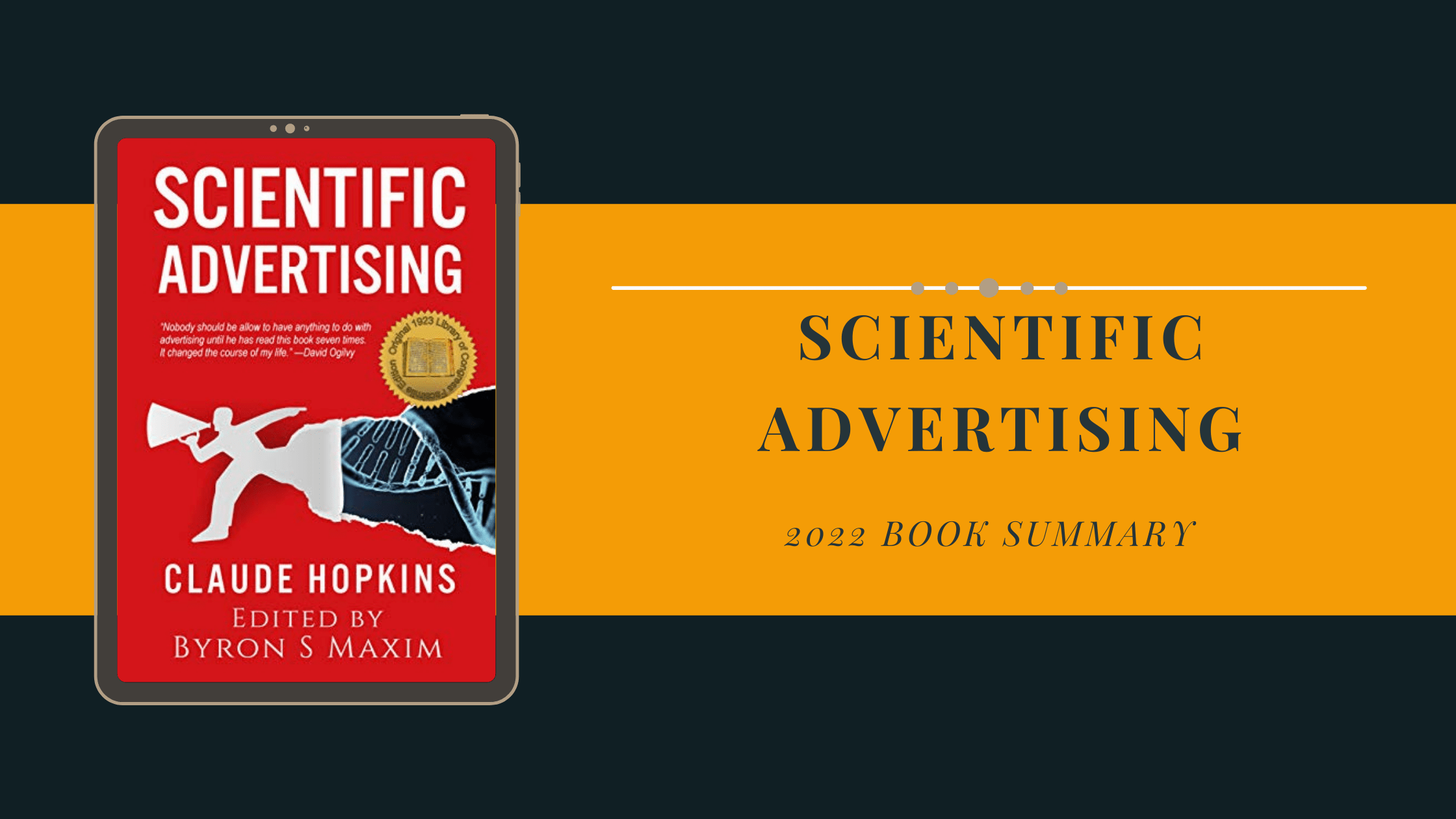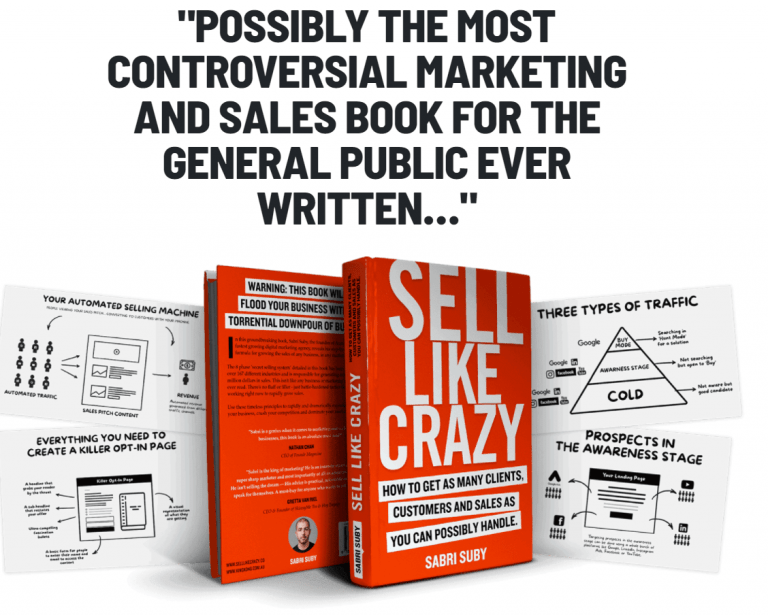Scientific Advertising Book Summary 2022
The book Scientific Advertising was written in 1923 by Claude Hopkins.
Nearly 100 years ago today, this was a time when modern advertising channels did not exist. Nobody had ever thought of the internet, let alone Google and Facebook ads.
The book focuses on advertising for newspapers, magazines and direct mail.
So you might wonder, is the information relevant in 2022?
In this post, I’ll summarize some of the key lessons from Scientific Advertising and how they do apply in the modern advertising world.
Salesmanship In Advertising
In one of the first (and most important) lessons of the book, Hopkins addresses one of the major mistakes made by advertisers…
They try to entertain rather than try to sell.
In 2022, this mistake is still commonly made in advertising. Think of all the ads you see on Facebook that try to attract people through catchy slogans or ‘clever’ and creative writing.
The people who are seeking entertainment are unlikely to be the people who will buy from you.
A modern-day example of this would be click-bait advertising. Many advertisers believe that they can use clickbait-style headlines and ads to bring more people to their landing pages and into their funnels.
In my review of the marketing book Sell Like Crazy, I criticize the author Sabri Suby for promoting the use of these clickbait tactics. Yes, clickbait does attract attention and clicks. But mostly from people who won’t buy from you.

If your goal is simply to get people onto your website and then monetize that traffic through display ads on the website, then clickbait can work well. Likewise, on YouTube, where creators earn more money by getting more views. Then clickbait and entertaining can be a profitable strategy.
But if your goal is to sell a product, then you should think like a salesman. Not an entertainer.
Mail Order Advertising
In his chapter about mail-order advertising, Hopkins talks about how people reading ads are very quick to forget about them. Even those who are possibly interested in the product being sold can easily be distracted by something else.
This is a far greater problem in 2022 than when Hopkins wrote the book back in 1923.
Advertisers are now competing with many more distractions. People have increasingly short attention spans.
Back in 1923, advertisers addressed this issue by including cut-out coupons in their ads. This prompted readers to cut out the coupon and put it somewhere that would remind them to revisit the ad later on.
In 2022, one of the most effective ways for digital advertisers to handle this problem is through remarketing. We can use remarketing to keep showing our ads to those who have visited our website but not converted or those that have engaged with our Facebook ads.
Another strategy in modern digital advertising is to capture an email address and continue to remind people of your product through email marketing.
The Best Ads To Learn From
The second key lesson of this chapter is to learn from mail-order advertising. These are ads that are directly prompting readers to place an order for a product through the ad.
These advertisers were better able to directly track the returns from their ads and discover what was working. If an ad wasn’t generating a positive return, the advertiser knew they would need to change their ad.
Although we have much better tracking and analytics today than advertisers did in 1923, many modern advertisers still struggle to properly track the returns on their ads.
A lot of digital advertisers are still unknowingly running unprofitable ads because they don’t have correct tracking systems in place. In some businesses that have long, complex sales cycles it can be challenging to get tracking right.
But e-commerce ads are an exception to this.

Because their transactions occur online, it’s generally much easier for e-com advertisers to accurately track the returns on their ad spend.
E-com ads are like the modern version of mail-order advertising. Because they can accurately track their returns, they can see what is working and what’s not working. So you can learn a lot from looking at the ads of larger e-commerce businesses.
Headlines
In his chapter on headlines, the one point Hopkins emphasizes is that your headline should capture the attention of the right person.
You can see an example of this in one of Hopkins’ more famous ads below…

You’re not trying to get everyone’s attention through your headline. Just those that are likely to buy what you’re offering.
People are too busy to stop and read everything they see. Back in 1923, magazine readers would only stop to read the articles which had a headline relevant to their interests. In 2022, Facebook users don’t stop to read every ad they see in their newsfeed. They only stop when something captures their attention.
For Facebook advertisers, I would argue that the headline is actually secondary to the image/graphic used in the ad. Your image is generally the first thing people notice in a Facebook ad because it takes up so much space.

As highlighted above, you can see that the text in the image is far more conspicuous than the actual headline (online guitar classes) below the image.
This is why I suggest that you consider the text in your image as the real headline in your Facebook ads.
Some marketing gurus advise that your Facebook ad should only contain an image with no text. They believe that these ads, look more like an organic Facebook post, thus don’t trigger people’s advertising defences.
Personally, I think this is a big mistake.
Text in your graphic is the best way to capture the attention of the prospects you want. It should be treated as your headline.
Advertisers Must Understand Psychology
Hopkins emphasizes how important it is for advertisers to understand human psychology.
He discusses a few of the main psychology phenomenons he has observed as an advertiser…
- Curiosity is one of the strongest human incentives
- Price influences people’s perception of a product
- Offers that are limited to a certain class of people (eg. veterans only) tend to outperform more general offers
Personally, I think the psychology behind advertising is overlooked by most modern advertisers, especially in the digital space.
Understanding human psychology is just as important today as it was in 1923. And the core principles of psychology haven’t changed since then.
Far too many Facebook and Google ad buyers over-focus on things like pixels, retargeting, campaign budget optimization… But they neglect the psychological aspect behind everything.
I’ve written many articles analyzing some of the most persuasive modern marketing campaigns and the psychology behind them.
To learn more about the psychological tactics used by some of the world’s most persuasive marketers, I suggest reading the following articles:
The Persuasion Psychology Behind Sabri Suby’s Sell Like Crazy Landing Page
The Psychological Tactics That InCruises Used To Attract 200k+ Members
Be Specific With Your Claims
Advertising “delivery within 24 hours” is much more powerful than “fastest delivery.”
Or “lose 25kg in 60 days” is more powerful than “lose weight fast.”
People are less likely to trust generalities in advertising and will often discard them completely. While a specific claim is more likely to be accepted as truth.
In 2022, this idea is just as true as it was when Hopkins wrote Scientific Advertising. People are still drawn to specificity. Yet many advertisers will still commonly use generalities in their advertising.
Consider these two webinar titles below. Both are promoting basically the same thing..

Which is more compelling? Clearly, the second one which makes a specific claim.
Of course, advertisers do face more regulations today than in 1923 about what claims you can make. While trying to be specific, you should also be careful to avoid misleading claims.


